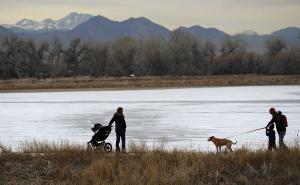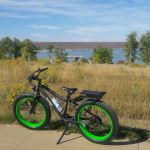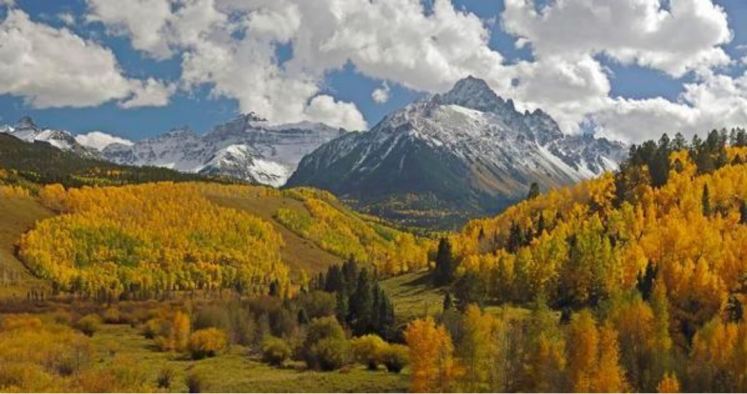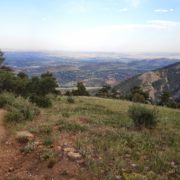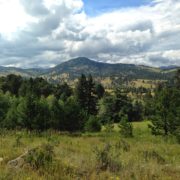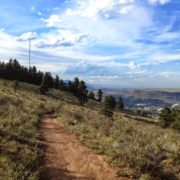Rugged New Black Bear Trail for Advanced Users Only
By Vicky Gits
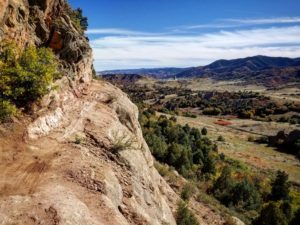
With 65 switchbacks in only 6.3 miles and a stunning cliff feature with a 50-foot drop, the new Black Bear Trail is one of the most challenging in the Jefferson County Open Space park system.
The trail connects two parks in South Jeffco, Deer Creek Canyon and Hildebrand Ranch. (For details see map at jeffco.us/parks, Deer Creek Canyon Park)
The Black Bear trail gets its name from the first attempt to build it in 1994, when workers on the downhill leg into Mill Creek at the time saw a black bear.
Later that year, trail construction came to an unexpected halt when an easement deal around the hogback near Hildebrand fell through. Twenty years later, Open Space revisited the idea of completing the trail, but on a different path.
Construction began Oct. 2016. Most of the work was in summer 2017. The trail opened in 2018.
The route starts near the summit of Plymouth Mountain and goes east, across two hogbacks, mostly downhill to Hildebrand Ranch trailhead.
The trail is open now but is closed seasonally for nesting raptors from Feb. 1 to July 31.
“Not for the squeamish”
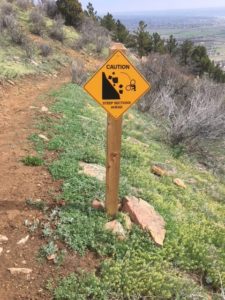
Sign on Black Bear Trail alerts bicyclists to dangerously exposed area known as The Ledge.
“When it first opened, people were pretty much amazed by it, especially when they hit the area called The Ledge,” said Jason Crum, Trails Team Lead, South Region.
The stretch that comprises the ledge is naked rock, no trees and nothing to halt a falling hiker or bicycle, as a warning sign amply illustrates. The Ledge looks precarious in photos, but is manageable at least 3- to 4-feet wide and is less steep and more sustainable than the alternative, Crum said.
It’s not all about The Ledge, though. Jeffco outdoor writer ] Steve Knapp said he appreciates the ecological and geological variety. “From dense pine forests you pass through high meadow before beginning to climb the first of two low hogbacks that stand in the way of Hildebrand.
“These two ridges offer a taste of high prairie, well-seasoned with flavors of the Southwest. Climbing the first ridge, the trail passes along a lofty stone ledge that, while not for the squeamish is unique within the JCOS system,” Knapp said.
The construction team consisted of about 10 people per day and included members of the Jefferson County Trail Stewardship Team, Team Works and the Mile High Youth Corps.
50 to 60 percent of steep

“The most difficult aspect of the build was the steepness of the side slope,” Crum said. “We shot anywhere from 50 to 60 percent (steepness) on up.” But with so many switchbacks the trail averages only about 10 percent grade, which is a system standard.
Another challenge was chewing through hogback bedrock. “We had to use a thing called Boulder Blaster, which uses water to fracture the rock, and a lot of jack-hammering,” Crum sai
No bailing out
Black Bear is not for the beginning hiker. It is rated difficult or black diamond in the park system’s rating system, primarily because it’s so long.
Endurance is the main issue, especially if it’s hot weather. Once you commit, there is no place to bail out, Crum said.
It’s about a 10-mile trip to make the circle from Hildebrand Ranch to Plymouth Mountain and Deer Creek Canyon Park. But many hikers start at Hildebrand, which entails a 15.8-mile journey to the start of Black Bear at the top of the mountain and back again. Hikers can save a couple of miles by staying on the road.
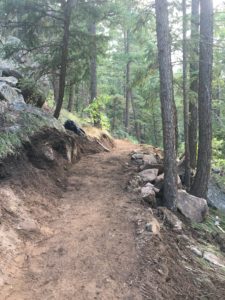
The Black Bear Trail travels through various ecosystems.
Black Bear Trail, a serious workout for bikers, hikers and especially the adventurous, but with plenty to offer the energetic nature-lover, as well.
********
TIMELINE
Black Bear Trail
Connecting Hildebrand Ranch Park to Deer Creek Canyon Park
Jefferson County Open Space
1994: Black Bear Trail built from Plymouth Mountain to Mill Creek and terminated at the second hogback from top. Trail is open to public but seldom used.
Oct. 2016: Construction begins again
Summer 2018: Trail opens for mountain bikes, hikers and equestrians
TRAIL FACTS
Info and Map: jeffco.us/parks, Hildebrand Ranch Park and Deer Creek Canyon Park. See both maps before setting out on hike.
65 switchbacks
6.3 miles length
6800 feet elevation at start on mountain
5750 feet elevation at Hildebrand Trailhead
10 percent average grade of trail
50 to 60 percent average grade of slope (90 to 100 percent is a vertical wall)
Surface and width: natural surface, 3 to 4 feet wide
The Ledge: 2.1 miles from the start of Black Bear Trail and Two Brands Trail to The Ledge
4,071 feet of chain link fence removed
3,443 feet of installed wildlife friendly HTF range fence
The wildlife-friendly fence is 3 ½ ft. tall with six strands of smooth wire vs. chain link fence that is 6 ft. tall. The wildlife fence is designed to allow easier movement for animals.
2,885 feet of installed chain link fence
4.8 miles of trail on Open Space property
1.5 miles on Lockheed Martin property using and easement agreement (mostly contained by new fence)
2.6 miles of trail built by contractor Arrowhead Trail
3.7 miles built by Jeffco Open Space


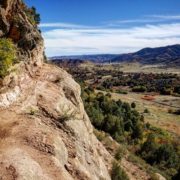
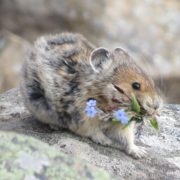





 Hillary Merritt, senior project manager with the Trust for Public Land’s Denver office, has been named deputy director of the Jefferson County Open Space Department. Her main responsibility will be land acquisitions. Open Space Executive Director Tom Hoby announced the decision on Thursday, May 2, at a meeting of the Open Space Advisory Committee. Her first day on the job will be June 17.
Hillary Merritt, senior project manager with the Trust for Public Land’s Denver office, has been named deputy director of the Jefferson County Open Space Department. Her main responsibility will be land acquisitions. Open Space Executive Director Tom Hoby announced the decision on Thursday, May 2, at a meeting of the Open Space Advisory Committee. Her first day on the job will be June 17.
